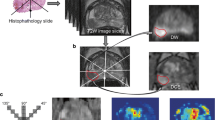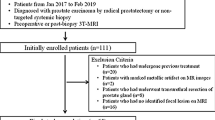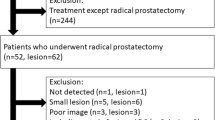Abstract
Objectives
To investigate Haralick texture analysis of prostate MRI for cancer detection and differentiating Gleason scores (GS).
Methods
One hundred and forty-seven patients underwent T2- weighted (T2WI) and diffusion-weighted prostate MRI. Cancers ≥0.5 ml and non-cancerous peripheral (PZ) and transition (TZ) zone tissue were identified on T2WI and apparent diffusion coefficient (ADC) maps, using whole-mount pathology as reference. Texture features (Energy, Entropy, Correlation, Homogeneity, Inertia) were extracted and analysed using generalized estimating equations.
Results
PZ cancers (n = 143) showed higher Entropy and Inertia and lower Energy, Correlation and Homogeneity compared to non-cancerous tissue on T2WI and ADC maps (p-values: <.0001–0.008). In TZ cancers (n = 43) we observed significant differences for all five texture features on the ADC map (all p-values: <.0001) and for Correlation (p = 0.041) and Inertia (p = 0.001) on T2WI. On ADC maps, GS was associated with higher Entropy (GS 6 vs. 7: p = 0.0225; 6 vs. >7: p = 0.0069) and lower Energy (GS 6 vs. 7: p = 0.0116, 6 vs. >7: p = 0.0039). ADC map Energy (p = 0.0102) and Entropy (p = 0.0019) were significantly different in GS ≤3 + 4 versus ≥4 + 3 cancers; ADC map Entropy remained significant after controlling for the median ADC (p = 0.0291).
Conclusion
Several Haralick-based texture features appear useful for prostate cancer detection and GS assessment.
Key Points
• Several Haralick texture features may differentiate non-cancerous and cancerous prostate tissue.
• Tumour Energy and Entropy on ADC maps correlate with Gleason score.
• T2w-image-derived texture features are not associated with the Gleason score.




Similar content being viewed by others
Explore related subjects
Discover the latest articles and news from researchers in related subjects, suggested using machine learning.References
Gondo T, Hricak H, Sala E et al (2014) Multiparametric 3T MRI for the prediction of pathological downgrading after radical prostatectomy in patients with biopsy-proven Gleason score 3 + 4 prostate cancer. Eur Radiol. doi:10.1007/s00330-014-3367-7
Salami SS, Vira MA, Turkbey B et al (2014) Multiparametric magnetic resonance imaging outperforms the Prostate Cancer Prevention Trial risk calculator in predicting clinically significant prostate cancer. Cancer 120:2876–2882
Klotz L, Zhang L, Lam A, Nam R, Mamedov A, Loblaw A (2010) Clinical results of long-term follow-up of a large, active surveillance cohort with localized prostate cancer. J Clin Oncol 28:126–131
NICE (2014) Prostate cancer: diagnosis and treatment. Available via http://www.nice.org.uk/guidance/CG175. Accessed 2015/01/31
Heidenreich A, Bastian PJ, Bellmunt J et al (2014) EAU guidelines on prostate cancer. part 1: screening, diagnosis, and local treatment with curative intent-update 2013. Eur Urol 65:124–137
NCCN NCCN Clinical Practice Guidelines in Oncology (NCCN Guidelines®) Prostate Cancer Version 1.2015 Available via http://www.nccn.org/professionals/physician_gls/pdf/prostate.pdf. Accessed 2015/01/31
Thrift AP, Whiteman DC (2013) Can we really predict risk of cancer? Cancer Epidemiol 37:349–352
Barentsz JO, Richenberg J, Clements R et al (2012) ESUR prostate MR guidelines 2012. Eur Radiol 22:746–757
Wang L, Mazaheri Y, Zhang J, Ishill NM, Kuroiwa K, Hricak H (2008) Assessment of biologic aggressiveness of prostate cancer: correlation of MR signal intensity with Gleason grade after radical prostatectomy. Radiology 246:168–176
Hambrock T, Somford DM, Huisman HJ et al (2011) Relationship between apparent diffusion coefficients at 3.0-T MR imaging and Gleason grade in peripheral zone prostate cancer. Radiology 259:453–461
deSouza NM, Riches SF, Vanas NJ et al (2008) Diffusion-weighted magnetic resonance imaging: a potential non-invasive marker of tumour aggressiveness in localized prostate cancer. Clin Radiol 63:774–782
Mazaheri Y, Shukla-Dave A, Hricak H et al (2008) Prostate cancer: identification with combined diffusion-weighted MR imaging and 3D 1H MR spectroscopic imaging–correlation with pathologic findings. Radiology 246:480–488
Jung SI, Donati OF, Vargas HA, Goldman D, Hricak H, Akin O (2013) Transition zone prostate cancer: incremental value of diffusion-weighted endorectal MR imaging in tumor detection and assessment of aggressiveness. Radiology 269:493–503
Vargas HA, Akin O, Franiel T et al (2011) Diffusion-weighted endorectal MR imaging at 3T for prostate cancer: tumor detection and assessment of aggressiveness. Radiology 259:775–784
Donati OF, Mazaheri Y, Afaq A et al (2013) Prostate Cancer Aggressiveness: Assessment with Whole-Lesion Histogram Analysis of the Apparent Diffusion Coefficient. Radiology. doi:10.1148/radiol.13130973:130973
Peng Y, Jiang Y, Yang C et al (2013) Quantitative analysis of multiparametric prostate MR images: differentiation between prostate cancer and normal tissue and correlation with Gleason score–a computer-aided diagnosis development study. Radiology 267:787–796
Coffey N, Schieda N, Cron G, Gulavita P, Mai KT, Flood TA (2014) Multi-parametric (mp) MRI of prostatic ductal adenocarcinoma. J Magn Reson Imaging 10:24694
Donati OF, Mazaheri Y, Afaq A et al (2014) Prostate cancer aggressiveness: assessment with whole-lesion histogram analysis of the apparent diffusion coefficient. Radiology 271:143–152
Haralick RM (1979) Statistical and Structural Approaches to Texture. Proc IEEE 67:786–804
Haralick RM, Shanmuga K, Dinstein I (1973) Textural Features for Image Classification. IEEE Trans Syst Man Cybern SMC 3:610–621
Niaf E, Rouviere O, Mege-Lechevallier F, Bratan F, Lartizien C (2012) Computer-aided diagnosis of prostate cancer in the peripheral zone using multiparametric MRI. Phys Med Biol 57:3833–3851
Lopes DFD, Ramalho GLB, de Medeiros FNS, Costa RCS, Araujo RTS (2006) Combining features to improve oil spill classification in SAR images. Proc SSPR 4109:928–936
Conners RW, Trivedi MM, Harlow CA (1984) Segmentation of a high-resolution urban scene using texture operators. Comp Vision Graphics Image Process 25:273–310
Oczeretko E, Borowska M, Kitlas A, Borusiewicz A, Sobolewska-Siemieniuk M (2008) Fractal analysis of medical images in irregular regions of interest. IEEE Intl Conf Bioinforma BioEngineering. 1–6
Tixier F, Le Rest CC, Hatt M et al (2011) Intratumor heterogeneity characterized by textural features on baseline 18F-FDG PET images predicts response to concomitant radiochemotherapy in esophageal cancer. J Nucl Med 52:369–378
Tan S, Kligerman S, Chen W et al (2013) Spatial-temporal [(1)(8)F]FDG-PET features for predicting pathologic response of esophageal cancer to neoadjuvant chemoradiation therapy. Int J Radiat Oncol Biol Phys 85:1375–1382
Yoo TS, Ackerman MJ, Lorensen WE et al (2002) Engineering and algorithm design for an image processing Api: a technical report on ITK–the Insight Toolkit. Stud Health Technol Inform 85:586–592
Martin K, Hoffman B (2008) Mastering Cmake: a cross-platform build system, 4th edn. Kitware Inc., New York
Huynen AL, Giesen RJB, Delarosette JJMCH, Aarnink RG, Debruyne FMJ, Wijkstra H (1994) Analysis of ultrasonographic prostate images for the detection of prostatic-carcinoma - the automated urologic diagnostic expert-system. Ultrasound Med Biol 20:1–10
Viswanath SE, Bloch NB, Chappelow JC et al (2012) Central gland and peripheral zone prostate tumors have significantly different quantitative imaging signatures on 3 tesla endorectal, in vivo T2-weighted MR imagery. J Magn Res Imaging 36:213–224
Acknowledgments
The scientific guarantor of this publication is Andreas Wibmer, MD. The authors of this manuscript declare no relationships with any companies whose products or services may be related to the subject matter of the article. The authors state that this work has not received any funding. Junting Zheng, Debra Goldman and Chaya Moskowitz kindly provided statistical advice for this manuscript. All have significant statistical expertise. Institutional Review Board approval was obtained. Written informed consent was waived by the Institutional Review Board. No study subjects or cohorts have been previously reported. Methodology: retrospective, experimental, performed at one institution.
Disclosure
There were no sources of support or conflicts of interest which require disclosure.
Author information
Authors and Affiliations
Corresponding author
Rights and permissions
About this article
Cite this article
Wibmer, A., Hricak, H., Gondo, T. et al. Haralick texture analysis of prostate MRI: utility for differentiating non-cancerous prostate from prostate cancer and differentiating prostate cancers with different Gleason scores. Eur Radiol 25, 2840–2850 (2015). https://doi.org/10.1007/s00330-015-3701-8
Received:
Revised:
Accepted:
Published:
Issue Date:
DOI: https://doi.org/10.1007/s00330-015-3701-8
Keywords
Profiles
- Harini Veeraraghavan View author profile




